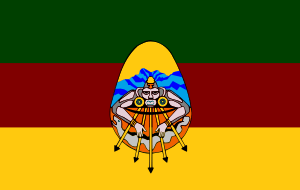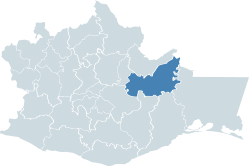Mixe people facts for kids
 |
|

The Sierra Mixe within Oaxaca, Mexico
|
|
| Total population | |
|---|---|
| ~90,000 | |
| Regions with significant populations | |
| Mexico (Oaxaca) El Salvador (Ahuachapan) | |
| Languages | |
| Mixe, Spanish | |
| Religion | |
| Roman Catholic, and Traditional religion | |
| Related ethnic groups | |
| Zoques |
The Mixe are an indigenous group living in the eastern highlands of Oaxaca, Mexico. They speak the Mixe languages, which are part of the Mixe–Zoque language family. The Mixe people have kept their language and traditions strong. About 90,000 Mixe people were estimated in 1993. They call themselves ayuujkjä'äy, meaning "people who speak the mountain language." The name "Mixe" might come from a word for "cloud" in the Nahuatl language.
Contents
Where the Mixe Live: The Sierra Mixe
The Mixe people live in a region called the Sierra Mixe. This area is in the northeast of Oaxaca. It borders the Valley of Oaxaca to the southwest. To the east are the lowlands of Tehuantepec. The highlands of Choapam and the state of Veracruz are to the north. This rugged and remote area is part of the Sierra Madre de Oaxaca mountains.
Different Areas of the Sierra Mixe
The western Mixe live in cool, mountainous highlands. Important towns here include San Pedro and Pablo Ayutla (called Tu'ukyom in Mixe). Other towns are Tlahuitoltepec (Xemgɨxp) and Totontepec (Añkɨwam). In these areas, which are over 2400 meters high, farmers grow maize (corn), beans, potatoes, and squash.
The midland Mixe live around Zacatepec (Mɨɨygɨxy) and Juquila (Kɨngɨ'ɨm). In this region, people grow coffee and chili peppers. The eastern Mixe live in the tropical lowlands. This area is near the city of Matías Romero. Here, at lower elevations, they grow tropical crops. These include bananas, plantains, and sugar cane.
Rivers and Mountains of the Mixe Region
The Mixe region is next to areas where Zapotecs and Chinantecs live. The Mixe have some contact with these groups. Three large rivers flow through the Mixe region. These are the Papaloapan, the Coatzacoalcos, and the Tehuantepec.
Three tall peaks rise above 3300 meters in the Sierra Mixe. These are Cempoaltepetl (called Ipxyukp, "the Mountain of twenty heads" in Mixe), Cerro Blanco, and Cerro Malinche.
A Look Back: Mixe History
Some experts think the Mixe might be connected to the ancient Olmecs. Other ideas suggest links to cultures in the South American Andes mountains. A Mixe legend says they settled at the holy mountain Cempoaltepetl. Here, led by the legendary king Condoy, they built a strong kingdom.
We don't know much about the Mixe before the Spanish arrived. There are few old buildings or written records in their area. But we do know that neither the Zapotec kingdom nor the Aztec empire fully conquered the Mixe.
Staying Independent from Spanish Rule
After the Spanish took over central Mexico, they sent a force to the Sierra Mixe. This group, led by Diego Sandoval, tried to conquer the Mixe and Chinantec people. But the expedition failed, and the Mixe remained free.
Hernán Cortés, a famous Spanish conqueror, even wrote about this. He told the King of Spain that the Zapotec and Mixe lands were the only ones not conquered. He said their land was very rocky and hard to cross. He also mentioned that the Mixe warriors were very fierce.
In 1555, the Dominican order began peaceful contact with the Mixe. They built churches and missions in towns like Juquila and Totontepec. The Mixe people are still proud that they were never fully conquered.
Mixe Culture and Daily Life
Most Mixe people live by farming. They grow corn, beans, squash, and potatoes to feed their families. They also hunt small animals and fish in rivers. In the last century, some midland Mixe began selling coffee. They are usually small farmers who sell their roasted beans to buyers from outside their area.
Music and Crafts
The Mixe are famous in Oaxaca for their large brass bands. Almost every Mixe town has a band that plays at local festivals. In some towns, people still weave traditional cloth using backstrap looms. Other towns are known for making ceramics.
Mixe Language
The Mixe language belongs to the Mixean branch of the Mixe–Zoque language family. Its closest relatives are Sayula Popoluca and Oluta Popoluca, spoken in Veracruz. Mixe is a complex language. It has different ways of showing who is doing an action.
The Mixe language has three main dialect areas. These are Highland Mixe, Midland Mixe, and Lowland Mixe. Many Mixe language versions are not well studied. However, some dialects, like those of Totontepec, have dictionaries and grammars.
Community Roles: The Cargo System
Besides the family, an important part of Mixe society is the cargo system. This system is a big part of how Mixe villages work. In this system, men in each village take on different public roles. These roles are called "cargos." They can be civic (community-related) or religious.
People holding a cargo have responsibilities for their community. This might include organizing religious celebrations or caring for religious statues. A cargo is an unpaid role and lasts for one year. Some cargos require the person to spend a lot of their own money. People who have held many cargos are highly respected. A few people who have held all possible cargos become part of a council of elders.
In some towns, the cargo system has faced challenges. This is because many Mixe people have become Protestant. This has sometimes caused social tension in the communities.
Mixe Religion and Beliefs
Mixe religious practices include prayers and offerings. They pray to a being called ‘The One Who Makes Being Alive’. This being is believed to give life. They also perform rituals for entities like the Rain, the Wind, and the Earth.
Mixe people believe that human life is built and shaped by the Creator. For example, the Mixe origin story describes the building of the earth. This process is similar to how pottery is made. Mixe newborns are given special baths. These baths are meant to make them strong, like pottery hardened in a kiln.
Gods and Calendars
Along with Catholic beliefs, the Mixe have their own gods. These gods represent different parts of life:
- Poj 'Enee ("Thunder wind") is a god of rain and fertility. He also protects Mixe towns.
- Naaxwiiñ ("Earth Surface") is a goddess of the earth and fertility.
- Yuuk is the "owner of the animals." He is the god of wild animals and hunting.
- Hɨgɨñ is a goddess of rivers and springs. Fishermen honor her.
- Mɨjku is a god of wealth, luck, hurricanes, death, and the underworld. He is sometimes linked to the Catholic devil.
The Mixe are one of the few groups in Mesoamerica who still use the 260-day ritual calendar. This calendar was used by many ancient cultures. The Mixe use it for telling the future and planning rituals. They also use it to choose names for children. Mixes have two names: a Mixe calendar name given at birth and a Spanish-Catholic name given at baptism.
Animal Counterparts: Nagualism
Nagualism is also part of Mixe religious beliefs. The Mixe believe that every person is born with an animal. This animal is their Tso'ok (animal counterpart). The animal carries part of the human's soul. Both the human and the animal share a common destiny.
Images for kids
See also
 In Spanish: Pueblo mixe para niños
In Spanish: Pueblo mixe para niños


